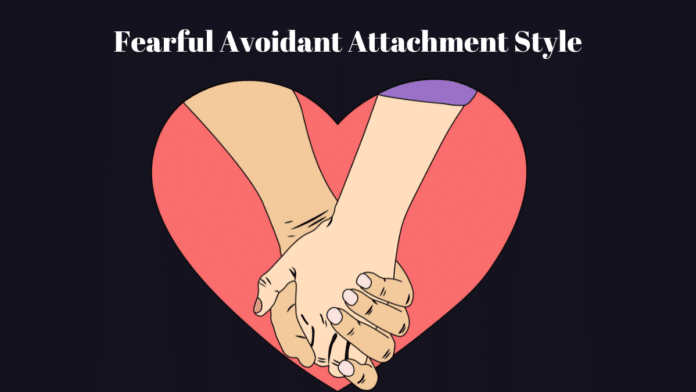Attachment styles play a significant role in shaping our relationships and emotional well-being. One of the most complex and challenging attachment styles is the fearful avoidant attachment style.
In this article, we will talk about fearful avoidant attachment, exploring what it is, its signs, and most importantly, how to deal with it.
What is fearful avoidant Attachment?
Fearful-avoidant attachment, also known as disorganized attachment, is a complex pattern of behaviour characterized by both high levels of anxiety and avoidance in relationships.
This attachment style is often caused by childhood experiences where the primary caregiver exhibits frightening behavior, ranging from overt abuse to subtle signs of anxiety or uncertainty.
What causes fearful avoidant attachment in adults?
Fearful avoidant attachment is a complex pattern of behaviour characterized by both high levels of anxiety and avoidance in relationships. It is often seen in adults who experienced trauma or abuse in their childhood.
Childhood Experiences
fearful-avoidant attachment typically develops in the first 18 months of life when a child’s caregiver exhibits chaotic, unpredictable, or abusive behaviour. This can include:
- Unreliable or inconsistent caregiving
- Physical or emotional abuse
- Neglect or abandonment
- Unpredictable or frightening behaviour from caregivers
These experiences can make a child feel unsafe, unloved, and unworthy, shaping their attachment style and relationships in adulthood.
Adult Characteristics
Adults with a fearful avoidant attachment style often exhibit the following characteristics:
- They may fear getting too close to others, fearing rejection, abandonment, or engulfment.
- They may avoid intimate relationships or push partners away to maintain control and safety.
- They may experience high levels of anxiety in relationships, fearing rejection or abandonment.
- They may exhibit erratic or unpredictable behaviour in relationships, making it difficult for partners to feel secure.
- They may struggle to regulate their emotions, leading to intense emotional reactions.
- They may have low self-esteem and feel unworthy of love and connection.
Trauma and fearful avoidant Attachment
Research suggests that trauma, particularly childhood trauma, can contribute to the development of fearful avoidant attachment. Trauma can lead to feelings of shame, guilt, and self-blame, which can further exacerbate the attachment style.
39 Signs of fearful avoidant Attachment
- You may struggle to form close relationships due to a deep-seated fear of intimacy.
- You may avoid expressing your emotions, fearing others will not understand or respond positively.
- You may struggle to regulate your emotions, leading to intense mood swings.
- You may fear rejection or abandonment, leading to a constant need for reassurance.
- You may struggle to trust others, fearing they will hurt or abandon you.
- You may avoid physical touch or intimacy, fearing that it will lead to emotional attachment.
- You may struggle to validate your emotions, leading to confusion and disconnection.
- You may fear being trapped in a relationship or situation, leading to a desire for independence.
- You may struggle to form emotional intimacy with others, fearing it will lead to emotional overload.
- You may fear being hurt or rejected, leading to a constant need for protection.
- You may struggle to resolve relationship conflicts, fearing that it will lead to abandonment.
- You may fear being abandoned or left behind, leading to a constant need for reassurance.
- You may fear being overwhelmed by emotions, leading to a desire for distance.
How to Deal with fearful avoidant Attachment
Here are some ways to deal with fearful avoidant attachment:
- Know your attachment style and its impact on your relationships.
- Work with a therapist to address underlying issues and develop healthier attachment patterns.
- Make clear boundaries to maintain emotional safety and intimacy.
- Express your needs and feelings openly and honestly with your partner.
- Engage in self-care activities to regulate your emotions and reduce anxiety.
- Learn to recognize and validate your emotions and develop emotional intelligence.
- Work on building trust with your partner by being consistent and reliable.
- Gradually build emotional intimacy with your partner, starting with small steps.
- Surround yourself with supportive people who understand and accept you.
- Practice mindfulness to reduce anxiety and increase emotional regulation.
The adult attachment style
The adult attachment style refers to how individuals perceive and respond to relationships in adulthood. It is shaped by the attachment experiences in early childhood, particularly the relationships with primary caregivers.
There are four main adult attachment styles: Secure, Anxious, Avoidant, and fearful avoidant (also known as Disorganized).
Secure Attachment Style
People with a secure attachment style tend to:
- Feel comfortable with intimacy and emotional closeness
- Trust others and themselves
- Communicate openly and honestly
- Manage stress and anxiety effectively
- Have a positive self-image and self-worth
Anxious Attachment Style
People with an anxious attachment style tend to:
- Fear rejection and abandonment
- Be overly dependent on their partner
- Be overly sensitive to their partner’s emotions
- Experience anxiety and stress in relationships
- Have a negative self-image and self-worth
Avoidant Attachment Style
People with an avoidant attachment style tend to:
- Avoid intimacy and emotional closeness
- Fear emotional dependence on others
- Prioritize independence and self-sufficiency
- Have difficulty with emotional expression and intimacy
- Have a negative self-image and self-worth
fearful avoidant (Disorganized) Attachment Style
Individuals with a fearful avoidant attachment style tend to:
- Have difficulty with emotional regulation and expression
- Experience anxiety and fear in relationships
- Avoid intimacy and emotional closeness due to fear of rejection and abandonment
- Have a negative self-image and self-worth
- May exhibit disorganized and unpredictable behaviour in relationships.
Conclusion
In conclusion, fearful avoidant attachment is a complex attachment style that can significantly impact relationships and emotional well-being. By knowing the signs and taking steps to address underlying issues, individuals can work towards developing healthier attachment patterns and building more fulfilling relationships.
FAQs
What is fearful avoidant Attachment Style?
Fearful avoidant attachment style is a pattern of attachment characterized by a mix of anxious and avoidant behaviours. Individuals with this style desire close relationships but simultaneously grapple with deep discomfort and distrust.
What are the causes of fearful avoidant Attachment Style?
Fearful avoidant attachment style often stems from intense fear, often as a result of childhood trauma, neglect, or abuse.
How do people with fearful avoidant Attachment Style behave in relationships?
Individuals with this style tend to feel they don’t deserve love or closeness in a relationship. They may view themselves as unworthy of responsiveness from their attachments and often do not trust their attachments’ intentions. They may seek less intimacy from attachments and frequently suppress and/or deny their feelings.















